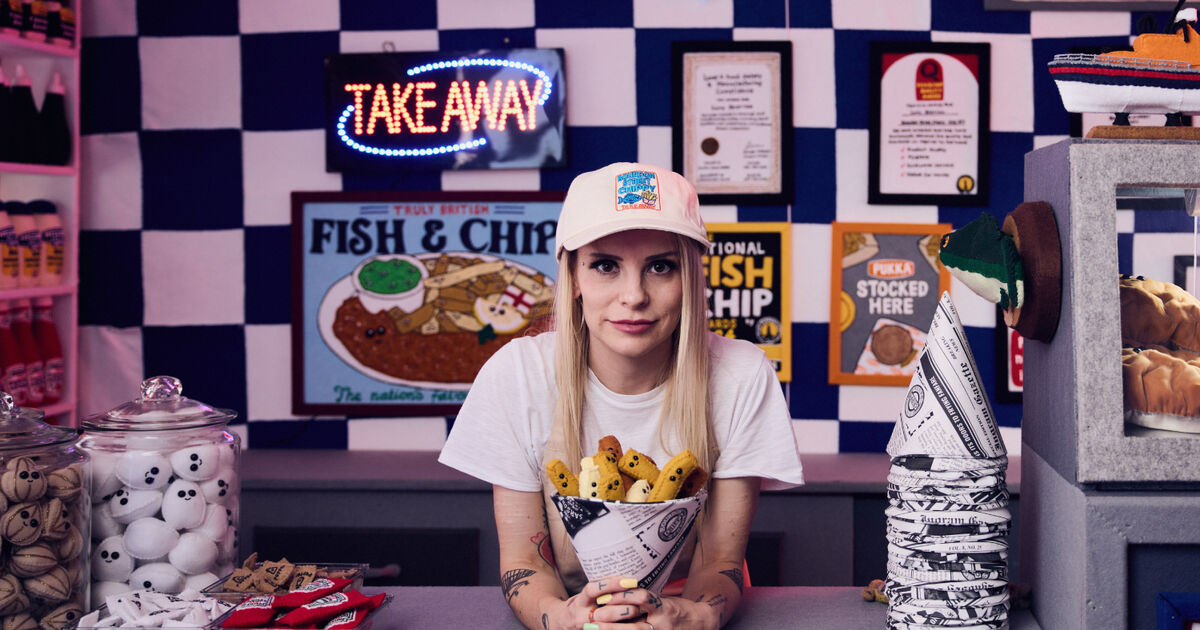At first glance, it’s a typical fish and chip shop. Signed portraits of celebrity regulars line the walls, and a packed counter displays battered cod, sausages, and mushy peas. “The Bourdon Street Chippy” offers everything you might expect from a traditional U.K. fried food purveyor, aside from the fact that all 65,000 items up for sale have been hand-crafted from felt by artist Lucy Sparrow.
This tactile reimagining of one of Britain’s most iconic establishments takes place in London’s Lyndsey Ingram, situated across two rooms of the gallery through September 14th. The counter is where Sparrow herself will be busy every day until the show’s close, serving her creations to paying customers who can take home a beaded pickle or smiley-faced piece of cod. “What I do is endurance art,” she told Artsy at the gallery. “I lock myself away for 11 months to make, and then go through a gruelling period of being behind the counter every day, as you would in a real fish and chip shop. That is the performance.”
Anthropomorphized with black, beady eyes and painted smiles, Lucy Sparrow’s felt creations are the stars of the show. “I can still appreciate a big museum or a white cube space,” she said, “but it has always been my intention for people to feel my art as much as look at it. And I soon realized that the interactions had when people visit are as much a part of the art as the pieces themselves.”
Sparrow’s first immersive installation, “Cornershop,” opened to the public in 2014 in Bethnal Green in East London. Displaying 4,000 felt renditions of chocolate, soft drinks, and newspapers, the pop-up included everything you’d see in a typical British convenience store. Over the past decade, her hand-crafted shops have cropped up globally. From a New York bagel store to a Bangkok street food cart, each installation is made entirely of felt and is more intricate than the last.
“The Bourdon Street Chippy”—the name of which is echoed on the branded tote bags, badges, and Sparrow’s own serving cap and apron—is a result of over five years of thought and three months of dedicated research. “I went to thirty or forty chippies and took ideas from all of them,” the artist said. She then put her own spin on her findings, intending to create an “amped-up, maximalist, multicolored version” of the British staple. Lining the wall behind the counter are playful felt posters advising “Do Not Feed the Seagulls” and “No Smoking,” alongside fake hygiene certificates and instructions on how to prevent food poisoning.
Everybody in the U.K. grew up with a local chip shop, and the exhibition plays on the idea that people tend to recall the past as being far more idyllic than it was in reality. “Everything seemed more technicolor, more fun, but also more simple back in the day,” Sparrow said. The artist wanted to emphasize the feeling of nostalgia that comes with fish and chips by “incorporating graphics that are basic and vintage, that have bright colors and solid patterns.”
Over the last decade, she said, items that have consistently proved the most popular are the ones that evoke a sentimentality. This may well be the same again this year, for against the windows at Lyndsey Ingram are shelves of instantly recognizable bottles, including Heinz Tomato Ketchup and Hellmann’s Mayonnaise. Next to them is a lesser-known player; Sparrow partnered with Cornish Sea Salt Company for this exhibition. “I aim to make the show as authentic as possible, and to do that I’ll include all of the big brands. However, it’s important to also platform smaller, British-owned companies.”
The meticulous, labor-intensive nature of Sparrow’s craft is a reflection, she thinks, of wider behaviors. In June, the artist revealed she’d been battling anorexia since her teenage years. “I know that I obsessively made art as a kid,” she told Artsy. “I obsessively did everything as a kid, which is unfortunately one of the horrible traits of anorexia. And I think that is so evident in the art that I make. When I was very ill as a teenager, I was so obsessed with food and thought about it night and day because I wasn’t eating it.” In recovery, her mindset has shifted. “I know that I need to stay well to have the energy to make these things. It’s almost like I owe the felt [creations]: They’ve looked after me, and I now need to look after them.”

